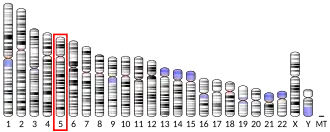G-protein coupled receptor 151 is a protein that in humans is encoded by the GPR151 gene.[5][6] It is weakly activated by galanin, but its endogenous ligand remains unknown. Studies have suggested GPR151 may play a role in several clinically significant processes such as inflammation, pain perception and reward-seeking behavior as well as hepatic glucose production, but further research into its function has been limited so far by a lack of selective agonists and antagonists for this receptor, with most research to date using knockout mice.[7][8][9][10][11]
References
- ^ a b c GRCh38: Ensembl release 89: ENSG00000173250 – Ensembl, May 2017
- ^ a b c GRCm38: Ensembl release 89: ENSMUSG00000042816 – Ensembl, May 2017
- ^ "Human PubMed Reference:". National Center for Biotechnology Information, U.S. National Library of Medicine.
- ^ "Mouse PubMed Reference:". National Center for Biotechnology Information, U.S. National Library of Medicine.
- ^ Vassilatis DK, Hohmann JG, Zeng H, Li F, Ranchalis JE, Mortrud MT, et al. (April 2003). "The G protein-coupled receptor repertoires of human and mouse". Proceedings of the National Academy of Sciences of the United States of America. 100 (8): 4903–4908. Bibcode:2003PNAS..100.4903V. doi:10.1073/pnas.0230374100. PMC 153653. PMID 12679517.
- ^ "Entrez Gene: GPR151 G protein-coupled receptor 151".
- ^ Holmes FE, Kerr N, Chen YJ, Vanderplank P, McArdle CA, Wynick D (January 2017). "Targeted disruption of the orphan receptor Gpr151 does not alter pain-related behaviour despite a strong induction in dorsal root ganglion expression in a model of neuropathic pain". Molecular and Cellular Neurosciences. 78: 35–40. doi:10.1016/j.mcn.2016.11.010. PMC 5235321. PMID 27913310.
- ^ Allain F, Carter M, Dumas S, Darcq E, Kieffer BL (November 2022). "The mu opioid receptor and the orphan receptor GPR151 contribute to social reward in the habenula". Scientific Reports. 12 (1) 20234. Bibcode:2022NatSR..1220234A. doi:10.1038/s41598-022-24395-z. PMC 9691715. PMID 36424418.
- ^ Bielczyk-Maczynska E, Zhao M, Zushin PH, Schnurr TM, Kim HJ, Li J, et al. (December 2022). "G protein-coupled receptor 151 regulates glucose metabolism and hepatic gluconeogenesis". Nature Communications. 13 (1) 7408. Bibcode:2022NatCo..13.7408B. doi:10.1038/s41467-022-35069-9. PMC 9715671. PMID 36456565.
- ^ Dai W, Wen M, Kalso E, Palada V (July 2025). "Circadian disruption upon painful peripheral nerve injury in mice: Temporal effects on transcriptome in pain-regulating sensory tissues". Neurobiology of Disease. 211 106934. doi:10.1016/j.nbd.2025.106934. PMID 40324566.
- ^ DePasquale O, O'Brien C, Gordon B, Barker DJ (May 2025). "The Orphan Receptor GPR151: Discovery, Expression, and Emerging Biological Significance". ACS Chemical Neuroscience. 16 (9): 1639–1646. doi:10.1021/acschemneuro.4c00780. PMC 12333004. PMID 40295925.
Further reading




